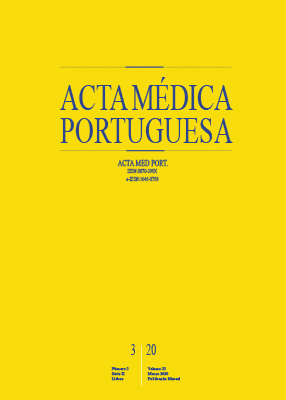Deteção da Infeção por Vírus da Imunodeficiência Humana e Outras Infeções Sexualmente Transmissíveis num Grupo de Trabalhadores/as do Sexo em Contexto Indoor na Área Metropolitana do Porto
DOI:
https://doi.org/10.20344/amp.11687Palavras-chave:
Diagnóstico Precoce, Doenças Sexualmente Transmissíveis/diagnóstico, Doenças Sexualmente Transmissíveis/epidemiologia, Infecções por VIH, Portugal, Profissionais do SexoResumo
Introdução: O diagnóstico precoce é uma ferramenta incontornável na contenção do vírus da imunodeficiência humana e de outras infeções sexualmente transmissíveis, nomeadamente em populações-chave, das quais fazem parte os/as trabalhadores/as do sexo. Apesar da sua relevância são ainda escassos os estudos epidemiológicos e intervenções que visem a monitorização e diagnóstico das infeções sexualmente transmissíveis em Portugal. Os objetivos do presente estudo são: (i) contribuir para um conhecimento mais aprofundado da epidemiologia de infeções sexualmente transmissíveis e (ii) avaliar a adaptação de métodos de rastreio em meio clínico ao contexto de proximidade em populações ocultas como os/as trabalhadores/as do sexo.
Material e Métodos: O rastreio de infeções sexualmente transmissíveis (vírus da imunodeficiência humana 1/2, vírus da hepatite B, vírus da hepatite C, sífilis, clamídia e gonorreia) foi realizado a 100 trabalhadores/as do sexo no âmbito da intervenção de proximidade realizada pelo Porto G na zona Metropolitana do Porto, entre setembro de 2015 e setembro de 2016.
Resultados: Foram identificados seis casos reativos para vírus da imunodeficiência humana, cinco de sífilis, oito de clamídia e dois de gonorreia. Não foram detetados resultados positivos para vírus da hepatite B e vírus da hepatite C. Os resultados foram discutidos tendo em conta a gradação de risco e de vulnerabilidade de infeções sexualmente transmissíveis nos diferentes subgrupos de trabalhadores/as do sexo.
Discussão: Os resultados deste estudo corroboram a necessidade de promover respostas integradas junto de populações mais afetadas pelo vírus da imunodeficiência humana e outras infeções sexualmente transmissíveis, como são os/as trabalhadores/as do sexo. Também neste grupo, os homens que fazem sexo com homens e as mulheres trans apresentam uma prevalência de vírus da imunodeficiência humana superior à das mulheres cis. As estratégias de intervenção devem ser informadas por estudos epidemiológicos rigorosos.
Conclusão: A adaptação da metodologia de rastreio realizada em meio clínico ao contexto de proximidade demonstra ser uma resposta inovadora em território nacional, nomeadamente em populações sentinela.
Downloads
Downloads
Publicado
Como Citar
Edição
Secção
Licença
Todos os artigos publicados na AMP são de acesso aberto e cumprem os requisitos das agências de financiamento ou instituições académicas. Relativamente à utilização por terceiros a AMP rege-se pelos termos da licença Creative Commons ‘Atribuição – Uso Não-Comercial – (CC-BY-NC)’.
É da responsabilidade do autor obter permissão para reproduzir figuras, tabelas, etc., de outras publicações. Após a aceitação de um artigo, os autores serão convidados a preencher uma “Declaração de Responsabilidade Autoral e Partilha de Direitos de Autor “(http://www.actamedicaportuguesa.com/info/AMP-NormasPublicacao.pdf) e a “Declaração de Potenciais Conflitos de Interesse” (http://www.icmje.org/conflicts-of-interest) do ICMJE. Será enviado um e-mail ao autor correspondente, confirmando a receção do manuscrito.
Após a publicação, os autores ficam autorizados a disponibilizar os seus artigos em repositórios das suas instituições de origem, desde que mencionem sempre onde foram publicados e de acordo com a licença Creative Commons









